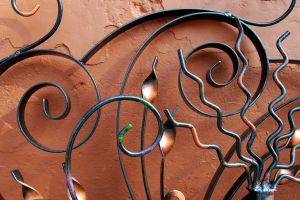When our forebears settled this country, life was different. Imagine heading west with your family and possessions in a covered wagon drawn by oxen. Space was at a premium. Among the few and precious items required for your survival and daily subsistence would be iron axes, drawknives, log tongs, an adze and a few other essential tools that would be used to chisel your new home out of a virgin land.
As the wagon trains assembled and started west, there was one person on whom the welfare and fate of the entire group depended: the blacksmith. With his anvil, hammers, and stores of iron and rods, he was responsible for keeping the horses shod, as well as repairing the wagon wheels, brackets, yokes, harness chains and items essential to keeping the train moving. When the settlers arrived at their destination, he would enjoy a special position in the new community, for without him there would be no settlement, as there were few or no stores to buy or repair the items to build your new home. If you were lucky to survive the arduous trip, your adventure had only started.
In your first year, establishing a home to protect yourself from the severe ravages of winter was a number-one priority. About 25 old-growth trees were adequate to build a luxurious 300-square-foot home for a family of six, as the trees were long and straight from their yearly competition to reach the sunlight available only at their uppermost levels in the forest. If you were awake when the sun rose over the village, you would smell the acrid smoke wisping skyward from the blacksmith’s forge and hear the repetitious clang of his hammer as it fell upon red-hot iron, sending stars of showering sparks with each blow. As you approached the dark opening of his shop, you would see the warm glow of his forge lighting the early morning.
There were many trips back and forth to the blacksmith to repair broken tools or to fabricate new ones. And as the home took shape in the forest, the trips back and forth increased, for the pioneer home was built largely from raw logs and forged-iron accessories. Apart from the tools required for building—the axes, adzes and drawknives—the blacksmith hammered latches, brackets, hinges, fireplace grates, pokers, shovels, pots, candle holders, hooks, trammels, spikes and nails out of iron to provide the basic items required to make the home functional. The tradition of the log home had begun, hand in hand with the black iron tools, fixtures and home accessories that characterize our romanticized past. Wrought iron and log homes symbolize our heritage. The log home’s beauty is characterized by an absence of straight lines and the bold character and natural beauty of the logs.
As the wagon trains assembled and started west, there was one person on whom the welfare and fate of the entire group depended: the blacksmith. With his anvil, hammers, and stores of iron and rods, he was responsible for keeping the horses shod, as well as repairing the wagon wheels, brackets, yokes, harness chains and items essential to keeping the train moving. When the settlers arrived at their destination, he would enjoy a special position in the new community, for without him there would be no settlement, as there were few or no stores to buy or repair the items to build your new home. If you were lucky to survive the arduous trip, your adventure had only started.
In your first year, establishing a home to protect yourself from the severe ravages of winter was a number-one priority. About 25 old-growth trees were adequate to build a luxurious 300-square-foot home for a family of six, as the trees were long and straight from their yearly competition to reach the sunlight available only at their uppermost levels in the forest. If you were awake when the sun rose over the village, you would smell the acrid smoke wisping skyward from the blacksmith’s forge and hear the repetitious clang of his hammer as it fell upon red-hot iron, sending stars of showering sparks with each blow. As you approached the dark opening of his shop, you would see the warm glow of his forge lighting the early morning.
There were many trips back and forth to the blacksmith to repair broken tools or to fabricate new ones. And as the home took shape in the forest, the trips back and forth increased, for the pioneer home was built largely from raw logs and forged-iron accessories. Apart from the tools required for building—the axes, adzes and drawknives—the blacksmith hammered latches, brackets, hinges, fireplace grates, pokers, shovels, pots, candle holders, hooks, trammels, spikes and nails out of iron to provide the basic items required to make the home functional. The tradition of the log home had begun, hand in hand with the black iron tools, fixtures and home accessories that characterize our romanticized past. Wrought iron and log homes symbolize our heritage. The log home’s beauty is characterized by an absence of straight lines and the bold character and natural beauty of the logs.












